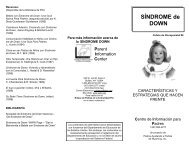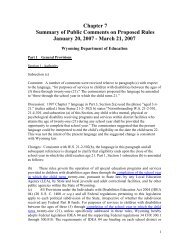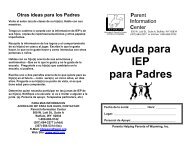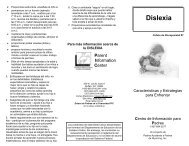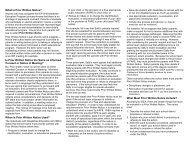Natural Environments - Parent Information Center
Natural Environments - Parent Information Center
Natural Environments - Parent Information Center
Create successful ePaper yourself
Turn your PDF publications into a flip-book with our unique Google optimized e-Paper software.
Part C of the 1997 Amendments to theIndividuals with Disabilities Education Act says,“to the maximum extent appropriate, earlyintervention services are provided in naturalenvironments.”Both parents and providers have questionsabout this provision. “What are “naturalenvironments? Where and how are earlyintervention services to be provided?The role of the IFSP TeamThe basis for all services and supports tochildren and families participating in Infant-Toddler Services is the development of theIndividualized Family Service Plan (IFSP). Thefocus of early intervention services is to increasethe family’s competence and capacity to meetthe needs of their child. Outcomes are designedfrom the family’s perspective: what is importantto them and what happens in their daily routines.The team that creates the IFSP should followthe family through their day, and develop anIFSP that supports the child’s developmentalactivities across environments. The team mustalso evaluate the child’s and family’s strengths,concerns and resources. Services are thenidentified and delivered within the context of thefamily’s life and community.Early intervention services are most effectivewhen routines, materials, and people familiar tothe family and child are used. The locationselected to provide these services should beone that maximizes the child’s and family’sopportunity to learn. Some reasons for this are:All children learn from one another.Familiar environments allow childrento focus on targeted learning.Interactions with children withoutdisabilities are linked to the child’sability to interact in adulthood withother adults.All children need to develop a senseof belonging.Children with disabilities have a rightto access the same environments asother children.The Community Inclusion Project says in TheSteps to Creating a Better IFSP that in naturalenvironments, “instruction occurs spontaneouslythrough naturally occurring routines and activities.Opportunities are provided for children to practiceskills that are functional for them. Each child mustbe permitted to direct the activity and makechoices. The early interventionist can target manylearning objectives during one activity. Forexample, a coloring activity can lend itself to theobservation of communication skills,social/sharing skills, motor skills, creativity andpractical knowledge.”Children with disabilities should receive servicesin community settings and places where normallydevelopingchildren and their families are found,so that they will not be denied opportunities thatall children have - to be included in all aspects ofour society.The natural environment may be very different fora baby who is two months old than for a two-yearold.The baby’s environment may be only homeand grandma’s house, while the two-year-oldsnatural environment may have expanded toinclude childcare/playgroup, the grocery store, themall, the nursery at church, playing with cousins atfamily gatherings, and attending a sibling’s sportsevents. There are many opportunities for learningin every environment.The family and early intervention team can look atthe different daily routines and activities, and findwhere best to work on the targeted skills. Forinstance with a child for whom the targeted skillsare acquiring sitting balance and increasedvocalizations, the time a team may choose to workwith the child is play time, and the tool they maychoose is a riding toy. The environment may beat home and/or at day care, and the personproviding assistance and encouragement may bethe early intervention teacher, a physical orspeech therapist, the childcare provider or theparent.Where should services be provided?For a young baby whose natural environment ismostly at home with mom, the early interventionteam may teach mom ways to provide stimulationduring diapering and bath times to reach thetargeted skills of increasing muscle tone andencouraging eye tracking. Mom may be taughtways to move the baby’s arms and legs or move abright toy through the child’s visual fields.Another way of looking at natural environment andthe child’s daily routine is with a child whosemother owns a business and her young babyspends his days with her at her shop. There aremany opportunities for stimulation in thisenvironment. The early interventionists canprovide services at the shop, showing mom, andperhaps other employees, ways of working withinthis environment and doing certain activities thatare enjoyable for the child and will meet targetedoutcomes.Childcare environments are obvious places formany children to receive early interventionservices because so many children now spendtime at childcare. The early interventionist may getall the children involved in an activity, which meetstargeted goals for the child with a disability, and isfun for all the children.Questions parents can ask:When choosing a natural environment setting fortheir child, parents can ask these questions:Is this a program in which my child wouldparticipate if he/she did not have disabilities?Does this program offer social interaction withnon-disabled peers?Is the program located near our home in thecommunity in which we live?To identify whether their child can participate fullyin the program, parents may want to ask:Is the primary intent of the activity thetreatment of disability or to meet the needs ofall the children?Are children with and without disabilitiesparticipating in the same activities?
Are children with and without disabilitiesinteracting with the same adults?Are all children using the same toys andmaterials?Are there any physical barriers betweenthe area children with disabilities use andthe area used by the rest of the group?Providing services in natural environments:‣ Decreases a family’s sense of isolation byconnecting families to natural sources ofsupport such as friends, neighbors orchurch members.‣ Encourages and assists families inidentifying their child’s strengths andtalents.‣ Helps families to build relationships that donot focus on their child’s disability ordifference.‣ Increases the social and languagecompetencies of children with disabilities.‣ Provides services to infants and toddlers insettings that are more stimulating andresponsive to their needs than segregatedsettings.‣ Provides normally developing childrenopportunities for positive interactions withchildren with disabilities.Providing services in natural environmentsdoes NOT:‣ Place children in settings withoutappropriate supports and services.‣ Keep families from networking with otherparents of children with disabilities.‣ Only provide home-based services.‣ Ignore individual needs and familyconcerns.‣ Place children in unsafe environments.‣ Create separate programs for youngchildren with disabilities.‣ Compromise the quality of earlyintervention services.‣ Place unreasonable demands on earlychildhood professionals or families.For more information aboutNATURAL ENVIRONMENTSCONTACT:<strong>Parent</strong><strong>Information</strong><strong>Center</strong>500 W. Lott St, Suite ABuffalo, WY 828341-800-660-9742 (WY only)(307) 684-2277 (v/tdd)(307) 684-5314 (fax)E-mail: tdawson@wpic.orgWebsite: www.wpic.orgTo talk with thePIC Outreach <strong>Parent</strong> Liaisonin your area, contact:PHP of WY is a non-profit, 501(c) 3organization; therefore, your donation istax deductible. We welcome all donations.Every donation helps us strengthen ournetwork of support for families.The contents of this brochure were developedunder a grant from the U.S. Department ofEducation. However, the contents do notnecessarily represent the policy of the Departmentof Education, and endorsement by the FederalGovernment should not be assumed.NATURALENVIRONMENTSDisability Brochure #12The Places Where YoungChildren Learn Best<strong>Parent</strong> <strong>Information</strong> <strong>Center</strong>1-307-684-2277A project of<strong>Parent</strong>s Helping <strong>Parent</strong>sof Wyoming, Inc.



